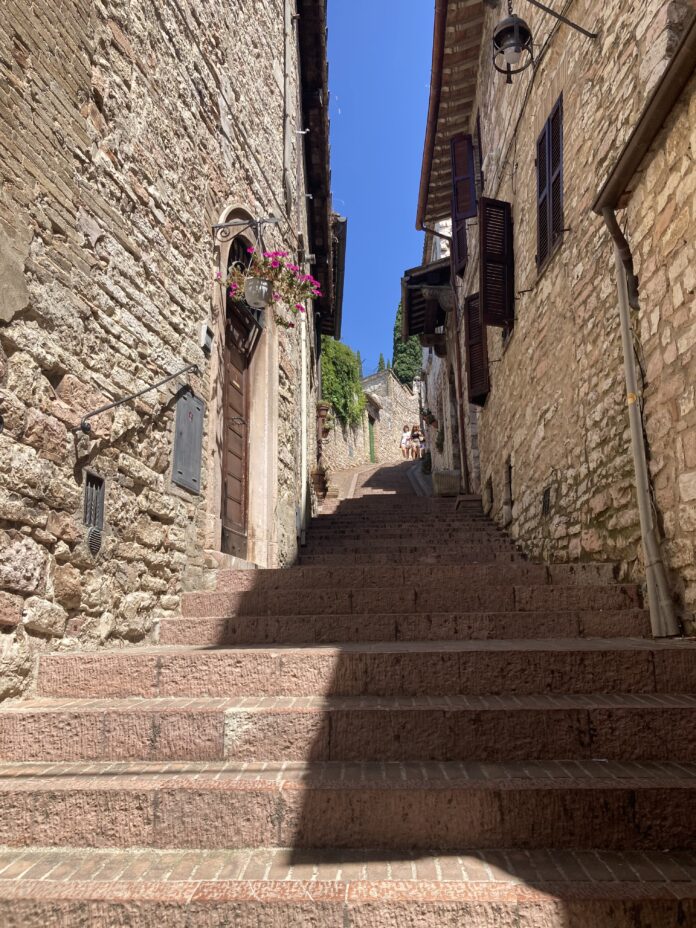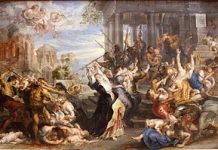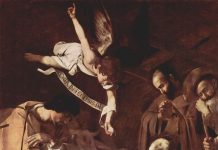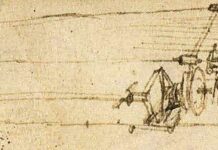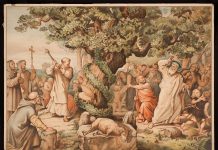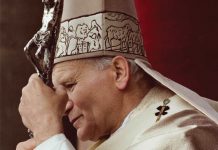I wasn’t quite prepared for Assisi, even if it was just what I needed. I suppose God works like that. When I got off the train in a place that looked something out of a spaghetti western, I felt a bit like a lost gunslinger, unsure which way to turn, and the choice will define his fate. I had only a vague idea of Assisi – I like being surprised – but some clue resided in the large domed church loomed over the blue skyline to the south, which I was later to discover was the basilica of Santa Maria degli Angeli. I thought, is that Assisi? Am I in Assisi? I was thirsty, hungry and tired, and so wandered over to a McDonald’s I had noticed as the train pulled into the station. No, not to eat – perish the thought! – but to use their free internet, a go-to when traveling to exotic locales. You can just stand outside. I discovered that the town I was in, even if the station was called ‘Assisi’, was named after the basilica and the shrine, and more on that in a moment.
Assisi proper was a couple of miles away, high up on the mountain overlooking Santa Maria, and what a sight it was. I have never seen such a place. Its beauty and tranquility and medievalism, even from a distance, look like it was transported straight out of the twelfth century, and in many ways, it was.
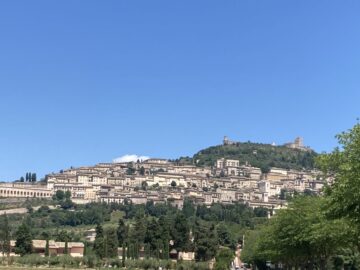
After fortifying myself with some local fare from a grocery store – also a good pilgrimaging custom- some prosciutto, fresh bread and local cheese, I began my hike up the steep roads. The glorious sight beckons one, drawing a soul through the heat and exhaustion, along the ancient, dusty roads, step by step, as though by a spiritual force. Like the plant that shielded Jonah, trees and shade are one’s friends in such a trek.
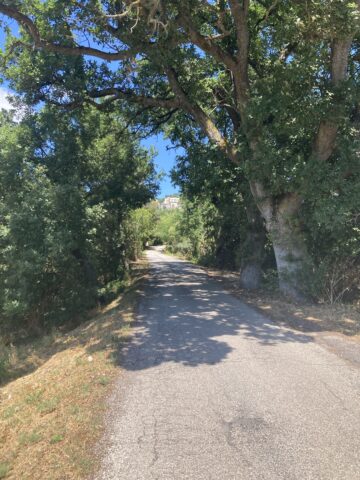
How do I put this into words? Assisi is Assisi, and I don’t think there’s anywhere else on earth quite like it. After the madding crowds of previous locales, its peace was welcome indeed. The narrow cobbled streets and alleyways twisting every which way, but always leading somewhere. Churches surprising one around many corners, lovely shops and cafes and restaurants – and the view, oh, the view! Over the Perugian valleys below and mountains around. Like Tuscany, I could never get used to it.
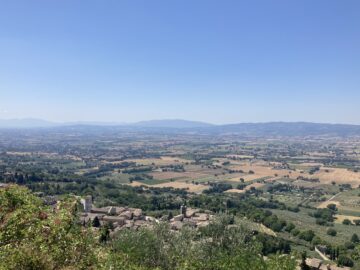
I had booked a room run in a Benedictine monastery named after Saint Joseph, which is also a convent of the Sisters who look after the place with some lay employees, and it was lovely. My room had wide shutters opening to the street below, swallows darting above agains the cerulean sky. I discovered that the monastery was stone’s throw from the small church of Santa Maria Maggiore – named after the great basilica in Rome – where the body of Blessed Carvalho Acutis rests. Before I went to my comfortable room, I prayed at his relics, which are still somewhat preserved.
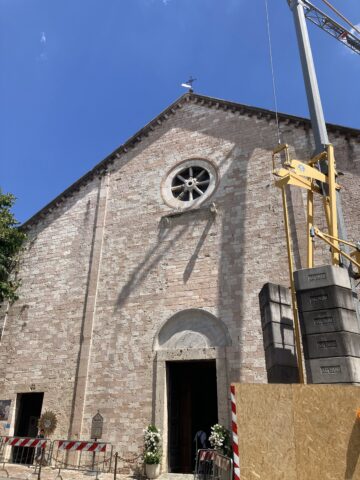
The short time I spent in Assisi was amongst the most peaceful I have ever had. I didn’t want to leave. I made my way to the great basilica dedicated to Saint Francis – the irony is palpable, for the humble friar would have railed against such a monument in his honour. Deus exaltivit humiles.
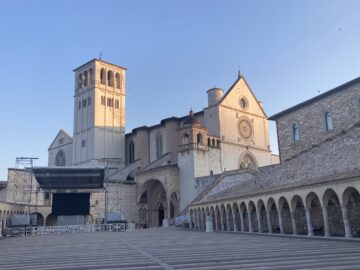
It was but a fifteen minute walk – everything in Assisi is close. I prayed in the lower church, and venerated the tomb of Saint Francis in the crypt, surrounded by the remains of some of his early disciples. Prayer was easy in such a place. I attended an evening Mass, followed by Vespers, sung by the Friars in a lovely Italian chant (even if my and the Church’s proclivity would be with Latin, but Italian is close, with Tuscan being derived from Latin). I could easily join in, and even mostly follow. One of the Friars then gave a spiritual discourse in Italian, which I could not quite follow, not having the text, but got a few words here and there.
Dinner was at eight sharp back at the convent, so I had to rush over, and shared a meal with three visiting American Benedictines, one hearty middle-aged priest who had been a former military logistics officer, and two younger Friar-seminarians, all of them on their way to study in Rome. They were in Assisi to immerse themselves in Italian. I was surprised at how many Benedictine monasteries there are in the U.S. There is much life in the Order. Sister serving us urged us to eat, the fine food accompanied by cold red wine, which almost makes sense in such a climate. It’s far better than a restaurant, the meals offered with agape, especially to those there for spiritual reasons.
I wandered through the village in the evening, never really getting lost, for the village is built into the mountain, and one just has to go ‘down’ to find one’s bearings. At night, it’s almost like a film set, the twisting alleys, cobblestone and flickering lights, only all too real. I met a family from California, Dad, Mum, and two high school children, who looked all the part, blond, tanned and exuberant, who helped run a private Catholic school in the very south of the state.
I slept soundly, and no wonder. Peace is in the very bones of this place.
The next morning, I made my way back to the basilica, and was just on time for the Office and Readings and Morning Prayers with the friars, followed by Holy Mass. I again sang along, helped by a priest I sat beside. Again, the sonorous, basso Italian, offered to God in praise by consecrated men, and a few female Franciscans, one of whom I met, from the University of Steubenville, of all places.
I had booked a late afternoon train to make my way to Rome, but with something of a heavy heart. I made the most of the day, exploring the rest of Assisi – or as much as I could – of the churches and relics. I went to the very top of the hill, where the remains of an ancient castle provide a tourist spot, and one of the most splendid views I have ever seen. The camera cannot capture what the eye, mind and heart see.
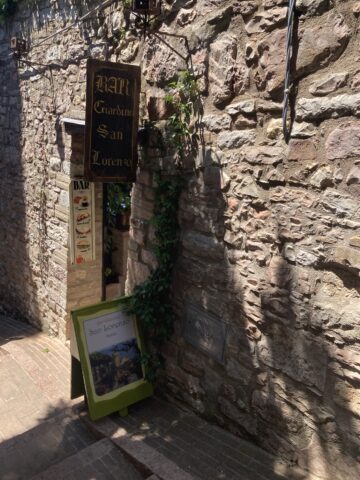
On the way back down, I noticed a small cafe named after one of my patrons, Saint Lawrence, so stopped in to enjoy an overpriced Italian ale, but worth every penny. As I enjoyed the brew and the view, I struck up a conversation with husband and wife and their son speaking English, with an Irish accent. It turns out they were from Belfast in Northern Ireland, and dyed-in-the-wool Protestants, but very pleasant. They were on a tour of Italy, and had made their way to Assisi, perhaps for its beauty, perhaps for deeper reasons. Saint Francis is nothing if not ecumenical, drawing all to God by his simplicity and goodness.
After a visit in the afternoon to the basilica of Santa Clara on the other side of the village – the two saints are like anchors holding Assisi, and perhaps the whole of Italy, together – I paid my final respects to Bd. Carlo, about to be canonized, and then my farewells to my gracious hosts at San Benedetto.
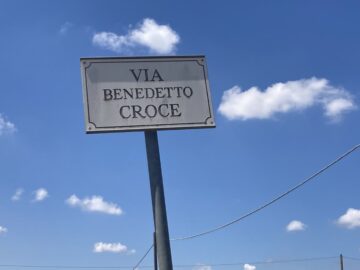
The walk down the mountain was pleasant, if hot and dry. I took a far less busy road than the one Google maps recommend on the way up – Google can, after all, be an idiot, as befits an unthinking algorithm, and I will say more of that anon. I had time to visit Santa Maria degli Angeli, which is a grand basilica built around the small, stone church which Saint Francis repaired. And there is the small, humble, but beautiful structure, dating back to the beginning of the 13th century, which Saint Francis helped to build, and in which he died, as he wished, lying on the ground. The stone church is fitting, in the middle of magnificence. I prayed a Rosary therein then to the 4:33 pm train to Rome.
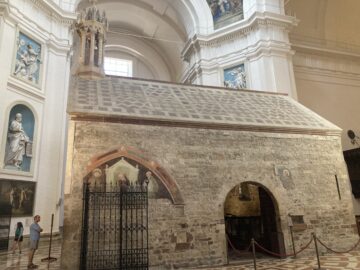
On the platform, there was a priest clad in white, with his parents, again speaking Inglese. I introduced myself, and it turns out he is a Norbertine, from their house in California, on pilgrimage. His parents had tried to visit while he was studying in Rome, but it was the middle of the Covid debacle, so the airline gave them a five-year rain check. And this was the fifth year. We had a pleasant conversation, and the priest knew a former student of mine who had tried his vocation with them. We parted ways, as they made their way to the first-class car. His parents were paying for it, and, anyway, as the Cistercian back in Frauenthal said, he always travels first class on train in Italy, since it’s not much more expensive than second class, and less than regular tickets in Switzerland.
We were all Rome bound, and I looked wistfully out the window as Assisi disappeared in the distance. I left a part of myself there, as, I suppose, we all do in some way. Francis is perhaps the most Christ-like of saints, the stigmata signifying his closeness to his divine Master. We all share some scintilla of his spirit, and would that spark be flamed into the fire of his own seraphic love.

